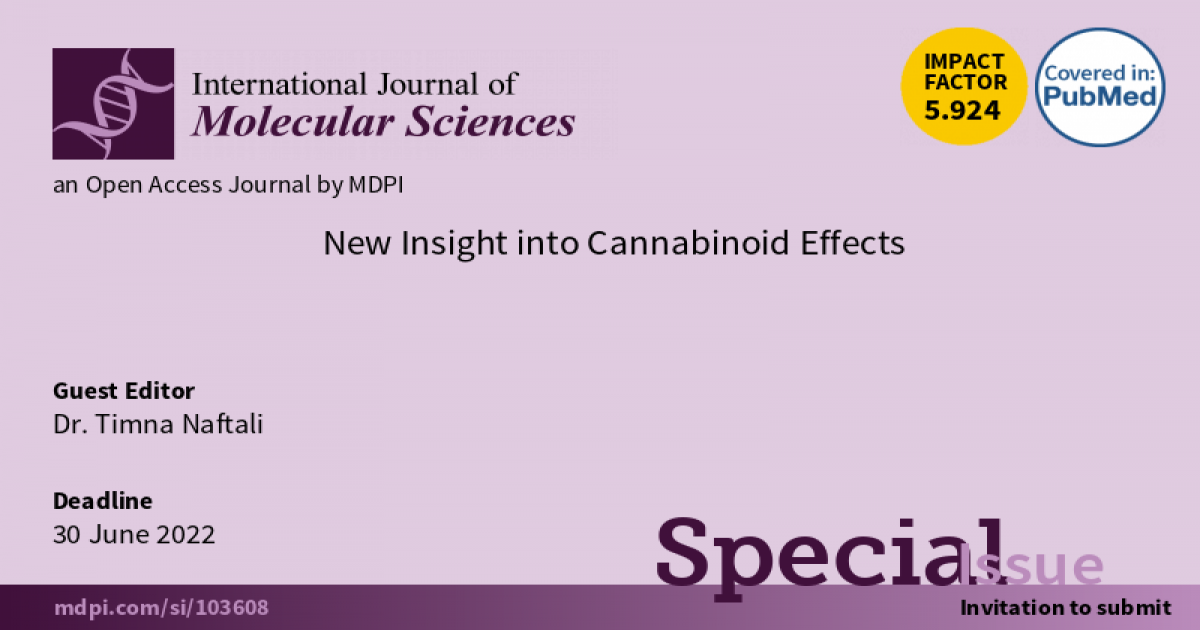New Insight into Cannabinoid Effects
A special issue of International Journal of Molecular Sciences (ISSN 1422-0067). This special issue belongs to the section "Bioactives and Nutraceuticals".
Deadline for manuscript submissions: closed (30 June 2022) | Viewed by 61672

Special Issue Editor
Interests: endocannabinoid; inflammatory bowel disease; cannabis use in IBD; cannabis
Special Issues, Collections and Topics in MDPI journals
Special Issue Information
Dear Colleagues,
Cannabis is the most widely used recreational drug worldwide. The cannabis plant contains as many as 100 phytocannabinoids as well as other ingredients such as terpenes and flavonoids. Phytocannabinoids exert their effects through the endocannabinoid system (ECS), which is an endogenous system with an important role in modulating mood, memory, reward homeostasis, immune regulation, and energy balance. The best-known phytocannabinoids are Δ9-tetrahydrocannabinol (THC), which is responsible for the psychotropic effect of cannabis, and cannabidiol (CBD), which does not have a central effect but is shown to have an anti-inflammatory effect.
The use of medical cannabis is rapidly increasing, and physicians are faced with an increasing demand from patients to prescribe it. Sadly, this is not accompanied by scientifically sound evidence regarding the efficacy, if any, of cannabis treatment. Very little is known about the effect of cannabis and the significance of various cannabinoid combinations or mode of cannabis consumption. On the other hand, we cannot afford to ignore the many reports about the positive effects of cannabis. More data and evidence on how cannabinoids affect physiology and pathophysiology and their therapeutic potential are urgently needed.
The open access journal, International Journal of Molecular Sciences (IJMS) (IF 5.923, ISSN 1422-0067), is therefore planning this Special Issue entitled “New Insight into Cannabinoid Effects”.
As the Guest Editor, I invite you to contribute an article to this issue. We promise you a rapid and rigorous peer review, manuscript handling, and editorial process.
Dr. Timna Naftali
Guest Editor
Manuscript Submission Information
Manuscripts should be submitted online at www.mdpi.com by registering and logging in to this website. Once you are registered, click here to go to the submission form. Manuscripts can be submitted until the deadline. All submissions that pass pre-check are peer-reviewed. Accepted papers will be published continuously in the journal (as soon as accepted) and will be listed together on the special issue website. Research articles, review articles as well as short communications are invited. For planned papers, a title and short abstract (about 100 words) can be sent to the Editorial Office for announcement on this website.
Submitted manuscripts should not have been published previously, nor be under consideration for publication elsewhere (except conference proceedings papers). All manuscripts are thoroughly refereed through a single-blind peer-review process. A guide for authors and other relevant information for submission of manuscripts is available on the Instructions for Authors page. International Journal of Molecular Sciences is an international peer-reviewed open access semimonthly journal published by MDPI.
Please visit the Instructions for Authors page before submitting a manuscript. There is an Article Processing Charge (APC) for publication in this open access journal. For details about the APC please see here. Submitted papers should be well formatted and use good English. Authors may use MDPI's English editing service prior to publication or during author revisions.
Keywords
- cannabinoids
- endogenous cannabinoids
- neurodegenerative diseases
- cancer
- pharmacology
Benefits of Publishing in a Special Issue
- Ease of navigation: Grouping papers by topic helps scholars navigate broad scope journals more efficiently.
- Greater discoverability: Special Issues support the reach and impact of scientific research. Articles in Special Issues are more discoverable and cited more frequently.
- Expansion of research network: Special Issues facilitate connections among authors, fostering scientific collaborations.
- External promotion: Articles in Special Issues are often promoted through the journal's social media, increasing their visibility.
- Reprint: MDPI Books provides the opportunity to republish successful Special Issues in book format, both online and in print.
Further information on MDPI's Special Issue policies can be found here.






